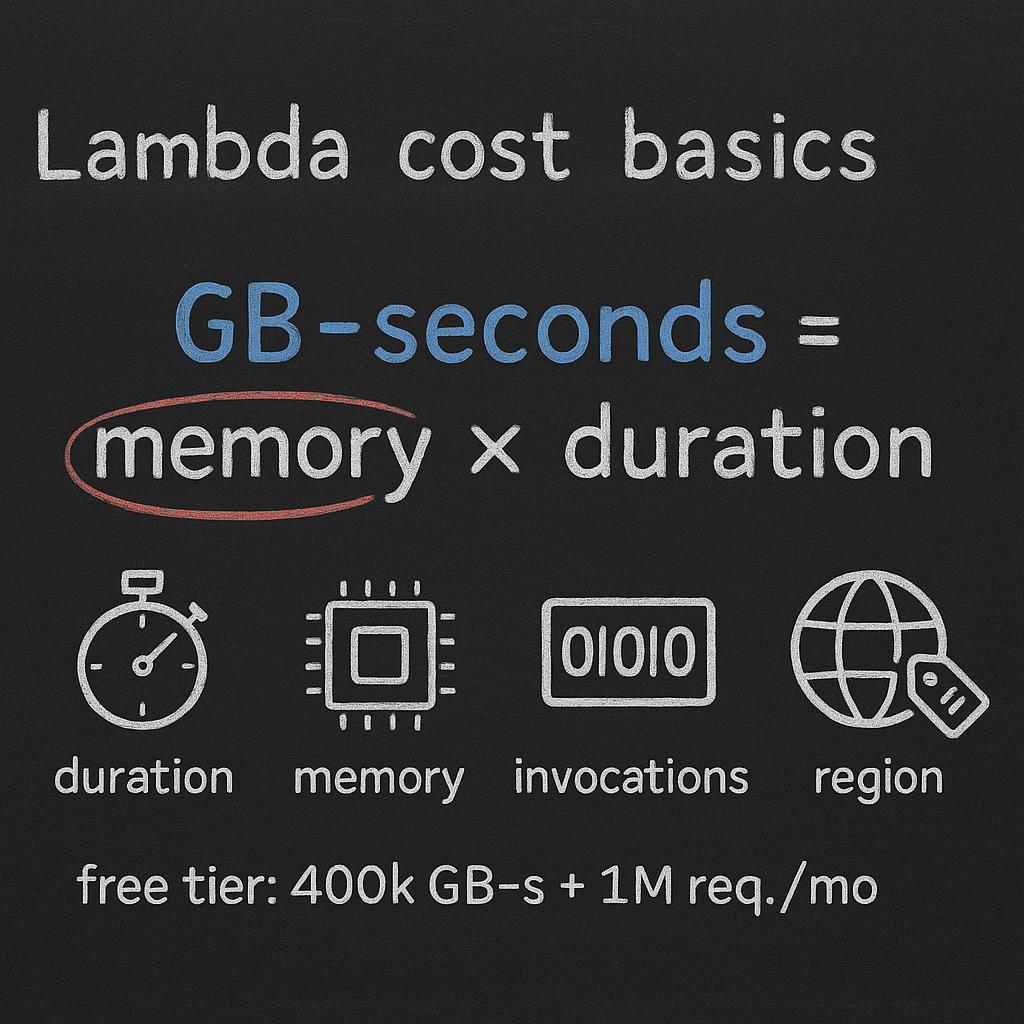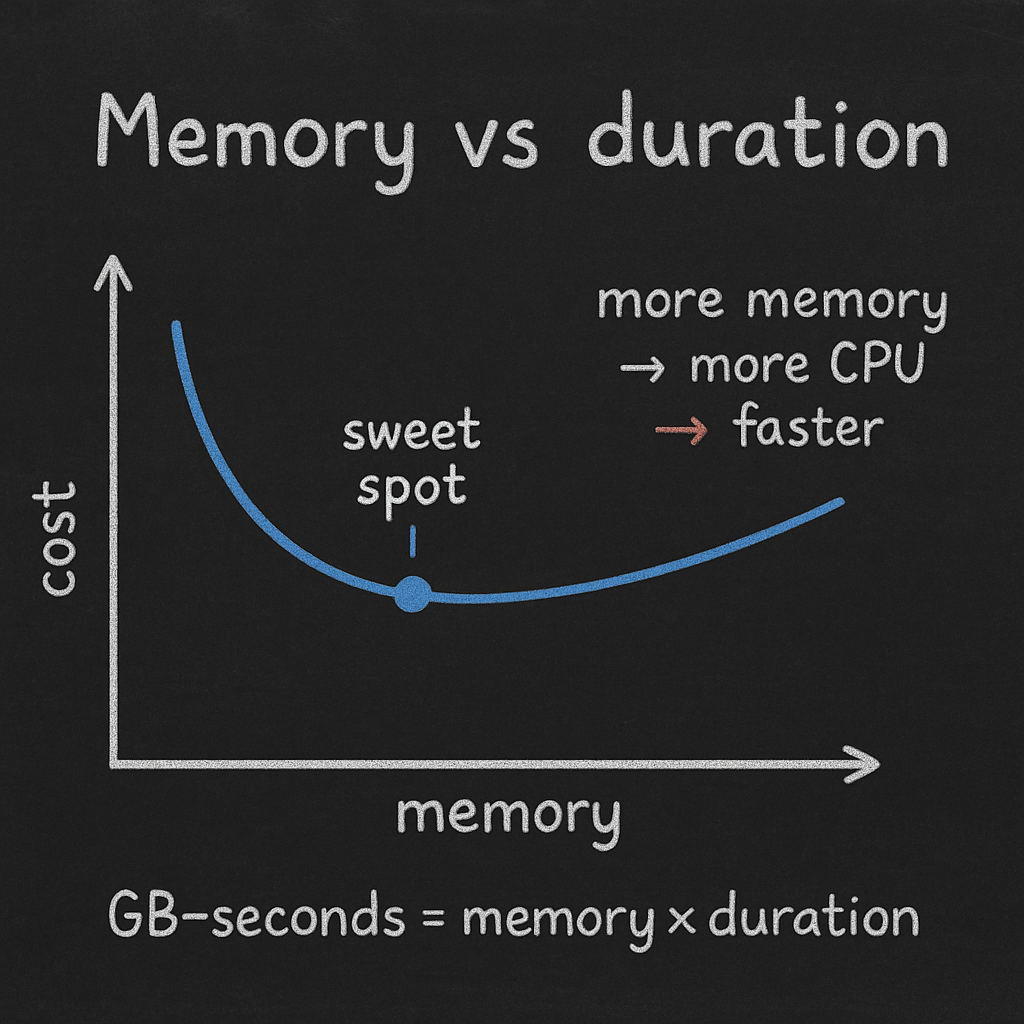AWS Lambda Cost Optimization: Smart Strategies for Maximum Savings
Are you watching your AWS Lambda costs climb while scratching your head about where the money is going? You’re not alone. With serverless adoption rising, many engineering teams are discovering that “pay for what you use” doesn’t automatically mean “pay less.” In fact, unoptimized Lambda functions can silently drain your cloud budget.

Understanding AWS Lambda Pricing Fundamentals
Before optimizing costs, you need to understand what drives your Lambda bill:
- Duration: Charged in GB-seconds (memory allocation × execution time) at $0.0000166667 per GB-second for x86 architecture in US East (N. Virginia)
- Invocations: $0.20 per million requests
- Free tier: Includes 400,000 GB-seconds and 1 million requests monthly
- Regional pricing: Varies significantly (US East Virginia is typically cheapest, with some regions costing 30-70% more)
Starting August 2025, AWS will begin charging for the initialization (INIT) phase for managed runtimes using ZIP file deployments, making optimization even more critical. Additionally, effective May 2025, Lambda logs will move to volume-based tiered pricing when using CloudWatch Logs Standard and Infrequent Access log classes.
Right-Sizing: The Foundation of Lambda Cost Optimization
The most immediate wins come from proper memory configuration. Functions default to 128MB RAM, but this isn’t always optimal. Consider running performance tests across memory configurations, incrementally testing from 128MB through 1GB+ to find the sweet spot.
The key is balancing duration versus memory. Sometimes higher memory reduces duration enough to lower overall costs. For example, a data processing function running for 10 seconds at 128MB (0.125GB) costs 1.25 GB-seconds. The same function might run for just 3 seconds at 512MB (0.5GB), costing 1.5 GB-seconds. While slightly more expensive, the faster response time might be worth it for your application.
Don’t forget to set realistic timeouts to prevent long-running functions from consuming excess resources:
Resources: MyFunction: Type: AWS::Serverless::Function Properties: Timeout: 3 # Start with conservative timeout valuesThe Memory vs. Duration Tradeoff
Lambda billing follows a simple formula: GB-seconds = memory (GB) × duration (seconds). This creates an interesting optimization opportunity:

CPU allocation scales with memory, meaning more memory equals more CPU power. Memory-intensive functions benefit directly from memory increases, while CPU-bound operations often run faster (and sometimes cheaper) with higher memory allocations.
The trick is finding the sweet spot where the reduced duration offsets the increased memory cost. This varies by function and workload type.
Cold Starts and Provisioned Concurrency
Cold starts impact both performance and cost. Provisioned concurrency creates always-ready instances, eliminating cold starts but charging for idle time.
This approach is cost-effective for high-traffic APIs with strict latency requirements but expensive for infrequently accessed functions or batch processing. You can configure it like this:
aws lambda put-provisioned-concurrency-config \ --function-name my-function \ --qualifier prod \ --provisioned-concurrent-executions 5If provisioned concurrency isn’t cost-effective for your use case, consider these cold start reduction strategies:
- Minimize dependencies to reduce initialization time
- Use Lambda SnapStart for Java functions to reduce cold starts by up to 90%
- Schedule periodic warm-up invocations for critical paths with unpredictable traffic
- Consider Node.js or Python, which typically have faster cold starts than Java or .NET
According to AWS, cold starts typically occur in under 1% of invocations, meaning INIT phase code executes approximately once per hundred invocations.
Choosing the Right Runtime and Architecture
The runtime and architecture you select directly impact performance and cost. AWS Lambda on Graviton2 (ARM) processors offers approximately 20% cost savings over x86 equivalents with comparable or better performance. To migrate:
Resources: MyFunction: Type: AWS::Serverless::Function Properties: Architectures: - arm64 # Switch from x86_64 to arm64For runtime selection, Node.js and Python generally have the fastest cold starts, while Java and .NET have higher cold start penalties but may perform better for complex processing. Custom runtimes should only be used when absolutely necessary, as they typically have longer initialization times.
Implement Batching and Asynchronous Patterns
Process multiple items per invocation to reduce total invocation costs. You can configure SQS to batch events before triggering Lambda:
Resources: MyEventQueue: Type: AWS::SQS::Queue Properties: # Configure batch size for Lambda consumption RedrivePolicy: deadLetterTargetArn: !GetAtt DeadLetterQueue.Arn maxReceiveCount: 3For non-time-sensitive operations, implement asynchronous processing by using Lambda destinations to chain functions without waiting, implementing fan-out patterns using SNS to parallelize workloads efficiently, or considering Step Functions for complex workflows with multiple Lambda invocations.
Cost Allocation and Monitoring
You can’t optimize what you can’t measure. Implement consistent tagging across your Lambda functions:
Resources: MyFunction: Type: AWS::Serverless::Function Properties: Tags: Environment: Production Service: PaymentProcessing Team: BackendSet up CloudWatch alarms for unusual Lambda behavior such as duration spikes (potential infinite loops or performance degradation), invocation count anomalies (possible runaway processes), or error rate increases (failed executions still incur costs).
Integrate with AWS cost management best practices for comprehensive visibility across your entire cloud infrastructure.
Lambda Compute Savings Plans
For predictable Lambda workloads, Compute Savings Plans offer significant discounts:
- 1-year commitment: Up to 17% savings
- 3-year commitment: Up to 27% savings
- Flexibility: Applies across multiple services (EC2, Fargate, Lambda)
Unlike Reserved Instances for EC2, Compute Savings Plans provide discount benefits across any region, instance family, size, or operating system, making them particularly valuable for organizations with diverse AWS usage patterns.
Tools and Automation for Lambda Optimization
Several tools can help you identify optimization opportunities:
AWS-native tools include AWS Compute Optimizer (provides right-sizing recommendations based on usage patterns), AWS Cost Explorer (analyze Lambda costs by function, tag, or time period), and AWS CloudWatch Lambda Insights (monitor performance metrics to identify inefficiencies).
Third-party solutions include Lumigo (provides Lambda-specific observability and cost breakdowns), Datadog (offers serverless monitoring with cost optimization recommendations), and Hykell (automates cloud cost optimization, focusing on identifying Lambda inefficiencies).
Real-World Lambda Optimization Examples
Consider this e-commerce order processing optimization:
- Original: 256MB Lambda with 400ms average duration
- Optimized: 1GB Lambda with 80ms average duration
- Result: 22% cost reduction despite 4x memory allocation, plus improved customer experience
Or this log processing pipeline:
- Original: Individual Lambda invocations per log entry
- Optimized: Batched processing with 10 logs per invocation
- Result: 87% reduction in invocation costs, 32% overall Lambda cost reduction
How Hykell Automates Your Lambda Cost Savings
Manual optimization is time-consuming and requires constant attention. Hykell provides:
- Continuous memory configuration optimization that automatically identifies the ideal memory/performance balance
- Timeout right-sizing that analyzes function execution patterns to recommend optimal timeout settings
- Idle function detection that identifies functions that could be consolidated or eliminated
- Architecture recommendations that suggest opportunities to move to Graviton2 where beneficial
- Concurrency optimization that calculates optimal provisioned concurrency levels based on traffic patterns
With Hykell’s automated approach, you can achieve up to 40% savings on your AWS Lambda costs without compromising performance or requiring ongoing engineering effort.
Actionable Next Steps
Serverless doesn’t have to mean uncontrollable costs. Start by auditing your current Lambda usage to identify your highest-cost functions. Then test different memory configurations for your top 5 functions, implement batching for high-volume operations, and apply consistent tagging for accurate cost attribution.
Ready to see how much you could save? Calculate your potential AWS Lambda cost reduction with Hykell’s free savings calculator today.
